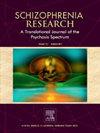压力敏感轨迹和精神分裂型的纵向研究:压力评估的回顾性和瞬时日常生活评估
IF 3.5
2区 医学
Q1 PSYCHIATRY
引用次数: 0
摘要
高应激敏感性是延长精神病表型(即分裂型)的一个易感性因素,但缺乏对其发展及其与分裂型的关联的纵向研究。本研究考察了压力敏感性作为一种特征的稳定性及其随时间的发展轨迹,并对其进行了回顾性和日常生活评估。此外,它还探讨了具有不同压力敏感轨迹的个体是否表现出不同程度的积极和消极分裂型。在三个时间点(T3 n = 102,年龄= 23.5;T4 n = 89,年龄= 25;T5 n = 168,年龄= 28)对非临床青壮年的应激敏感性进行回顾性测量,同时采用经验抽样法进行瞬时测量。在最后的时间点评估精神分裂的维度。三种纵向建模技术被用来评估和分类个体随时间的压力轨迹。在回顾性和瞬时测量中,应力敏感性随时间的推移表现出总体稳定性,揭示了两个轨迹等级(高和低)。除了短暂的情境压力外,高压力敏感性班级的稳定性持续存在。持续高压力敏感性超过4.5年的个体报告阳性和阴性分裂型升高。回顾性测量显示,积极分裂型的影响很大,消极分裂型的影响中等,而瞬时评估没有这种关联。研究结果表明,即使对年轻人进行评估,压力敏感性也是一种稳定的特征。通过回顾而不是瞬间测量更有效地捕获稳定性-与瞬间反应的上下文驱动性质一致。这些结果与压力敏感性在扩展精神病表型的因果途径中的作用一致。了解压力敏感性的特征可能有助于深入了解精神病发展中的风险、保护和机制。本文章由计算机程序翻译,如有差异,请以英文原文为准。
A longitudinal study of stress-sensitivity trajectories and schizotypy: Retrospective and momentary daily-life assessments of stress appraisals
Heightened stress-sensitivity is a vulnerability factor to the extended psychosis phenotype (i.e., schizotypy), but longitudinal studies on its development and association with schizotypy are lacking. This study examines the stability of stress-sensitivity as a trait and its trajectories over time, assessed both retrospectively and in daily life. Additionally, it explores whether individuals with varying stress-sensitivity trajectories exhibit different levels of positive and negative schizotypy. Stress-sensitivity was measured in non-clinical young adults at three time points (T3 n = 102, age = 23.5; T4 n = 89, age = 25; T5 n = 168, age = 28) both retrospectively with Perceived Stress Scale and momentarily with experience sampling methodology. Schizotypy dimensions were assessed at the final time point. Three longitudinal modeling techniques were used to assess and classify individuals’ trajectories of stress over time. Stress-sensitivity exhibited overall stability over time across both retrospective and momentary measures, revealing two trajectory classes (high and low). Stability persisted in high stress-sensitivity classes, except for momentary situational stress. Individuals with persistently high stress-sensitivity over 4.5 years reported elevated positive and negative schizotypy. Retrospective measure revealed a large effect for positive and a medium effect for negative schizotypy, while no such associations for momentary assessments. Findings indicate that stress-sensitivity is a stable trait, even when assessed in young adults. Stability was more effectively captured through retrospective rather than momentary measures−consistent with the contextually-driven nature of momentary responses. These results align with stress-sensitivity role in the causal pathway of the extended psychosis phenotype. Understanding the characterization of stress-sensitivity may offer insight into risk, protection, and mechanisms in psychosis development.
求助全文
通过发布文献求助,成功后即可免费获取论文全文。
去求助
来源期刊

Schizophrenia Research
医学-精神病学
CiteScore
7.50
自引率
8.90%
发文量
429
审稿时长
10.2 weeks
期刊介绍:
As official journal of the Schizophrenia International Research Society (SIRS) Schizophrenia Research is THE journal of choice for international researchers and clinicians to share their work with the global schizophrenia research community. More than 6000 institutes have online or print (or both) access to this journal - the largest specialist journal in the field, with the largest readership!
Schizophrenia Research''s time to first decision is as fast as 6 weeks and its publishing speed is as fast as 4 weeks until online publication (corrected proof/Article in Press) after acceptance and 14 weeks from acceptance until publication in a printed issue.
The journal publishes novel papers that really contribute to understanding the biology and treatment of schizophrenic disorders; Schizophrenia Research brings together biological, clinical and psychological research in order to stimulate the synthesis of findings from all disciplines involved in improving patient outcomes in schizophrenia.
 求助内容:
求助内容: 应助结果提醒方式:
应助结果提醒方式:


